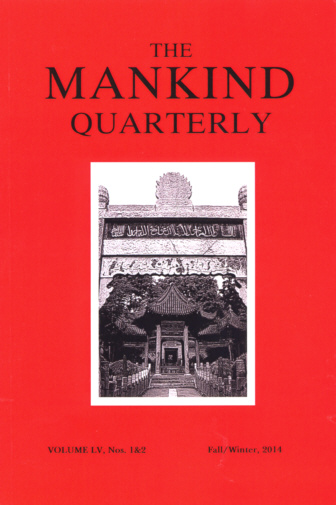
|
||
A Commonplace ProcedureNeurotic TransferSimon Sheppard‘Neurosis and Neurotic Transfer’ was published in Mankind Quarterly, Vol. 55, Nos. 1&2, Fall/Winter 2014, pp. 81-100 |
Abstract: Procedural Analysis is a novel psychological approach based on evolutionary precepts in which male and female are held to employ opposing strategies. The approach is applied in a theoretical exploration of neurosis, and a return to an elementary Pavlovian definition of neurosis is proposed. Several concepts within PA are mentioned such as compound benefit and neurotic suspension. Neurotic transfer is defined and five commonplace examples are given: a male made neurotic by female non-attendance; a prospective partner derogating herself; the nervous public speaker; dispelling a temptation to steal; and the well known but poorly understood phenomena of exaggerated and voluntary false confessions.
Keywords: Neurosis; Evolutionary psychology; Human behavioral model; Sex differences; Voluntary false confessions
Definitions
Neurosis: Nowadays the term neurosis has come to mean a generalized state of anxiety, “a mild mental illness, not attributable to organic disease, characterized by symptoms of stress” (Shorter Oxford English Dictionary, 2002). The hope is to reclaim the term for a specific psychological reaction: the mental condition which arises when one stimulus evokes two or more responses.
Neurotic transfer is transferring power to an opponent, motivated by neurosis. In game-theoretic terms, a Protagonist induces neurosis in an Opponent, and the Opponent responds, not by retaliating, but by transferring power to the Protagonist. The Opponent’s reaction strengthens the Protagonist (or a subsequent, similar neurosis-inducer, another member of the population). Equivalently, the Opponent may disarm himself in some manner. Either way, following a neurosis-inducing event created by the Protagonist, the Protagonist’s position is fortified.
The Original Model
Sometimes the action which leads to the persistent neurotic state is obvious, and can be readily identified as the neurosis-inducing event. Consider the following sequence, a ‘boy meets girl in the city’ story if you will. A male meets a female, somehow, among the crowds. They share a coffee, or a drink, and get on. He asks her to meet him for an outing in a few days time, and a place and time of meeting are agreed. He is greatly attracted to her, in fact he has hidden the extent of it from her (males bond to females more quickly than vice versa, for obvious evolutionary reasons).
The time of the appointment arrives and with it comes a bombshell, for she does not show up. He has looked forward to their meeting: he has made plans and perhaps even bought tickets. He waited nervously but the climax of the appointed time passes without any sign of her. This, patently obvious in this example, is the NIE, the neurosis-inducing event.
The reason for her non-attendance is irrelevant, certainly to the male, for it will probably never be known. She has been economical with information so he cannot contact her. The city center serves thousands of people from outlying areas, visitors and tourists and meeting her again by chance, and paying enough attention to recognize her, is quite unlikely. She is forever lost.
Sometime later he meets another girl. Again the male is attracted to her and again a rendezvous is arranged. By now however, a persistent neurotic state has been established. He fears that, like last time, she will not turn up. His conflict is between his pleasurable anticipation of meeting her again, and his fear that he will again be let down. He expresses his fear by seeking affirmation: “You will turn up, won’t you?” and this is neurotic transfer, for in his neurotic state he has made his position worse.
Due to his neurotic state – persistent from the previous occasion when a girl he desired did not show up – he has transferred power to the female. By expressing his fear he has conveyed significant information. His neurotic utterance tells the female at least three things. First, that he has been let down before, maybe several times. Second, he is evidently anxious that she will attend, counteracting any pretense of nonchalance he has made; this enhances her, increasing her confidence and power. Third, at some point between now and the rendezvous the possibility of not attending will occur to her, and she may surmise that it is common practice in this environment for females not to turn up to meetings with males. The probability that she will not attend is increased.
The neurotic male further empowers the female. By the neurotic transfer of power he has strengthened his opponent, and she is his opponent, because although there is potential for symbiosis between the players in this game, it is still a long way off. Moreover, as is common to many female procedures, action towards a single male is of benefit to females generally. The failure of the first female to attend has induced a persistent neurotic state, and by neurotically expressing his fear of its repetition he has empowered a subsequent one.
This dual benefit combination is an example of compound benefit. This occurs when a procedure confers multiple benefits, not necessarily confined to the individual performing the action. In this example the first female player has acted both as an individual and in some degree as a member of a population. Her actions have raised the cost of sex in both ways.